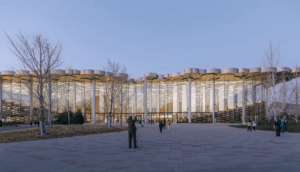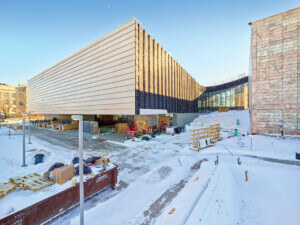Recently Gregory Hurcomb sat down with Craig Dykers and Nic Rader of internationally-based Snøhetta to discuss some of their latest projects on the boards in the San Francisco office. Given the new SFMOMA, Hurcomb wanted to consider how they were moving forward with new and dynamic proposals that help rethink architecture’s relationship with landscape, nature, the public, and sustainability. As the firm often looks to engage the user in compelling ways through the use of vast spaces located somewhere between landscape and architecture, how do they work to create these places and think about the ever-evolving hand of the designer in relationship to the world’s ever–shifting environment.
The Architect’s Newspaper: Is there something new on the boards here in San Francisco?
Nicolas Rader: We have a project on the corner of Market Street and Van Ness, right near the office, in the heart of the downtown area. We’re working with a great client called Build, Inc., who does a lot of work and is very well respected in San Francisco. It’s a very ambitious project, a 40-story condominium tower, but to us, the most interesting part is the proposal to close down part of Oak Street where it meets Van Ness to create a new public plaza. Of course, the client has an interest in the tower, but they also really want to improve the neighborhood as a whole. It will provide an amenity that is really fantastic for the city overall.
Is the general plan to make it more pedestrianized?
NR: Yes, more pedestrianized. There will be some artistic wind canopies in the plaza as well. The intersection is incredibly windy and can be so strong that it often knocks people over. We’re currently working with engineers to figure out the structural optimization for those.
How would you say the firm approaches the idea of land and the natural? For the project here in San Francisco, we could consider the artistic wind canopies and look at wind as a natural phenomenon pushing against us. How does that connect to your design process?
Craig Dykers: Many people misunderstand our relationship with landscape. I think many people naturally assume that our work is to merge things together, to merge architecture and landscape and vice-versa. While that does occur on some projects, there are other projects where merging is the opposite of what we want to do. Sometimes you want to push back against nature. The more important issue is having a dialogue, and that is where we always begin. We always want to find out what the relationship of a condition is to a project. That could mean merging things, or it could mean ignoring them or to make a point, just so long as the dialogue exists. In that sense there is a character of understanding the invisible as well as the visible. Some of the context might be things that you can’t see: cultural context, psychological context, driven by things beyond the nature of sight, or the place itself. In addition, we do quite a good deal of branding and graphic design work as well. With identity creation, we also like to get physical, so that even our branding work very directly connects you to a place. For example, we most recently designed Norway’s new bank notes, which speak to the Norwegian coastal landscape.
Building on the connection between architecture and landscape, what would you say is your design approach? Is it cultural from the beginning, or is it more specific to the job and the client?
CD: We don’t necessarily think of ourselves as tailors but there is a certain degree of that involved. Our projects often begin with conversations about what people might find valuable. Sometimes those conversations are internal among the design team; sometimes they are external. We often go out and talk to people in the community surrounding the site. We’ve begun many projects by interviewing people on the street. It’s always a little embarrassing to walk up to complete strangers and ask them to speak into a microphone when you’re not a TV or media journalist, but it’s important for us to hear what they have to say. We also work closely with specialists to hear what they think and we try to create something that is built around all of those understandings. Now that doesn’t mean that if someone says this we say the same thing back. We’re not just a sponge. We also have our own ideas and ways of seeing things. And that is the core of how a project begins: can we create something that is surprising and familiar at the same time?
NR: We often approach a project with questions, even if we think we know the answers. Certainly, we contribute some answers but we gather as much information from others as we can just to get a more holistic view. Then, we apply critical filters to it to better understand the best solution.
CD: Many architects today rely on a form of abstraction in their research. Mapping technologies and other ways of analyzing information are very interesting to us. But our work is always grounded in a more intuitive understanding, and a less abstract way of manipulating knowledge.
What does sustainability mean to the firm?
CD: Well, there are many types of sustainability: economic sustainability, cultural sustainability, environmental sustainability, and one of the things that we like to talk about is intellectual sustainability. How can we expect to manage nature if we can’t manage human nature? Human nature, emotions, and perspectives are all somewhat out of our control. You just have to pick up the newspaper to see all of the rivalries and polarity that exists in the world. Our work tries to create a sense of intellectual capacity through socialization. A kind of social interaction that builds awareness that will help people commit to other, more direct forms of sustainability, like environmental sustainability.
NR: In a way, I often think it’s sort of dangerous even to talk about sustainability because it’s something that should be inherent in practice and in discourse. By calling it out as something special or something separate assumes that some people choose to ignore it, which in itself is a problem. My approach is a little bit different because I don’t sit here and talk about sustainability. I wouldn’t consider myself ‘green’, or even talk about intellectual sustainability, but it’s something that I try to integrate into the way that I think and practice.
Well I bring it up mainly because I think because it is a somewhat contentious word these days, and possibly always, because there is a movement that
is associated with “green” architecture. One of the noteworthy aspects about Snøhetta for me is an inherent ecological awareness and a certain connection to the earth in your projects.
NR: What I appreciate about our work and our approach is that we’re not known as “sustainability architects” or “sustainability designers.” It’s embedded so deeply into our design that there is an assumption—and a genuinely accurate assumption—that it’s just there.
CD: What you’re saying is really important. I think many people who are working with this mindset have sort of marginalized themselves. They’ve said, well, we’re not like those people over there, we’re like these people over here, and you’re either one of us or one of them. And I don’t think that’s healthy.
In some regards perhaps it is too isolationist of a stance. We’ve created a camp or a group and we’re just over there talking amongst ourselves with this singular set of concerns, these particular thoughts and ideas.
CD: And then the conversation becomes, “if it doesn’t look environmentally sustainable then it can’t possibly be,” or “if it looks good then it can’t possibly be environmentally sustainable.” Or more often, it goes in the other direction, where someone says it’s ugly, therefore it must be environmentally friendly. And on that note, I’d like to consider the notion of interactivity and the promotion of diversity in architecture. I think it does have a very large impact eventually on how we function as a society in dealing with very large complex issues, like the environmental conditions of the earth we live on. You won’t be able to solve it one building at a time, although that helps. But you also have to create a condition where people start to think differently about who they are when they walk through a city, or when they walk into a building. They are thinking about their place in this wider world that we all live in…and that is where intellectual sustainability supports environmental sustainability.










